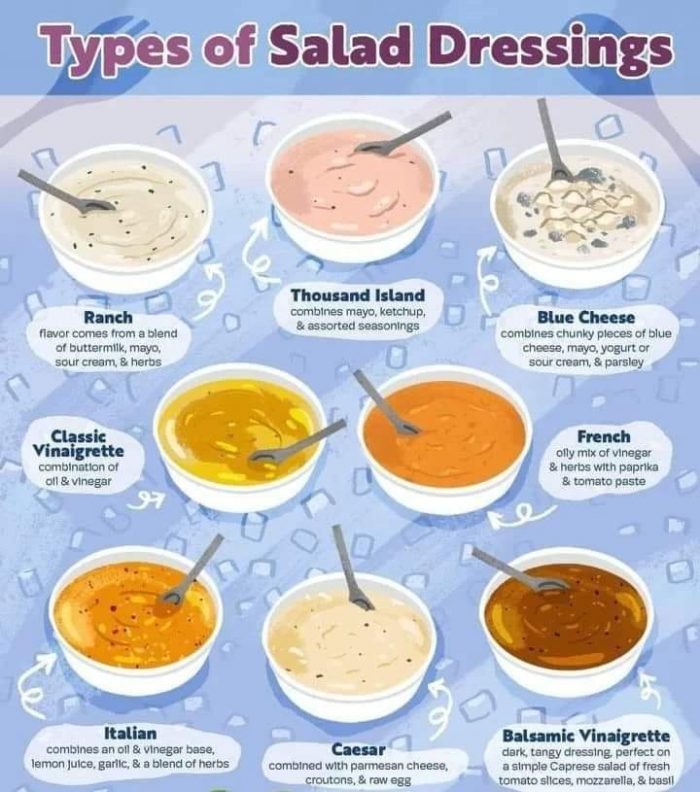
Salad dressing is one of the most important components of any salad. It’s what makes the dish taste good, after all! But did you know that there are many different types and styles of salad dressing? Whether you’re looking to make a classic Caesar or a tangy blue cheese vinaigrette, there’s a sauce here for you. Here are eight classic sauces and how best to use them:
Ranch
Ranch dressing is a popular choice for salads, especially when paired with chicken or iceberg lettuce. It also makes a great dip for french fries! Ranch dressing is made from mayonnaise, buttermilk and sour cream. The main ingredients are often seasoned with onion powder, garlic powder and dried dill weed.
Thousand Island
Thousand Island dressing is a classic American condiment. It’s made with mayonnaise, relish and ketchup. The combination of sweet and tangy flavors makes this dressing popular on salads and sandwiches alike. The Thousand Island dressing was invented in the 1880s by restaurateur George Remus at his restaurant in Detroit, Michigan. He named it after an island near Niagara Falls where he often vacationed with family members–and presumably enjoyed eating salads there!
Blue Cheese
Blue cheese dressing is a creamy dressing made with blue cheese. It’s often served on salads that include spinach and other greens, but it’s also good with pasta salads. Blue cheese pairs well with chicken, ham or turkey. Blue cheese dressing can be made at home by combining 1 cup sour cream or mayonnaise with 1/2 cup crumbled blue cheese (such as Roquefort), plus salt and pepper to taste.
Classic Vinaigrette
A classic vinaigrette is typically made with oil, vinegar and mustard. The ratio of ingredients can vary depending on your taste preferences and what you’re using it for (e.g., salad dressing vs marinade). For example: 1 part vinegar to 3-4 parts oil + 1 teaspoon dry mustard powder = Classic Vinaigrette that’s perfect for salads or vegetables
French
French dressing is a classic salad dressing that’s been around for nearly a century. It’s made with white wine vinegar, garlic and mustard, herbs (like tarragon), salt and pepper to taste, olive oil slowly whisked in while you’re mixing it all together in a bowl with a fork or spoon until smooth. If your dressing isn’t thick enough yet you can add more vinegar if needed! French dressing is best served on fresh greens like lettuce or arugula–but don’t forget about tomatoes!–and topped off with croutons or nuts like walnuts or almonds if desired. Store any leftover French dressing in an airtight container in the fridge so it doesn’t go bad before next time!
Italian
Italian dressing is a simple vinaigrette made with olive oil, vinegar, garlic and herbs. It’s also known as “red sauce” because of its bright red color and bold flavors. The base of an Italian salad dressing is typically olive oil and vinegar; however other ingredients such as herbs (such as oregano or basil), lemon juice or even anchovies can be added to give it more depth. Italian salads are usually served with fresh vegetables such as tomatoes and bell peppers; however they can also include meatballs or chicken strips if you prefer something heartier than greens alone!
Caesar
Caesar dressing is similar to Italian dressing, but it’s made with mayo instead of oil. To make a Caesar salad dressing, you’ll need mayonnaise (or salad cream), garlic powder or minced garlic cloves, lemon juice or vinegar, Worcestershire sauce and black pepper. The amount of each ingredient will depend on how strong your taste buds are and what kind of flavor you want in your salad. The most popular way to use this type of dressing is as a dip for vegetables and chips–you can also use it as an accompaniment for chicken or fish dishes!
Balsamic Vinaigrette
Balsamic vinegar is a thick and sweet vinegar that comes from Italy. To make balsamic vinaigrette dressing, add 1 part balsamic vinegar and 2 parts olive oil to a bowl. Mix well with a whisk until the ingredients are combined. You can also use an electric hand mixer or food processor for this step if you have one available! When using it as a salad dressing, drizzle some over your favorite greens before adding any other toppings like nuts or veggies (the recipe above will make enough for 4 servings). Or try mixing it into cooked pasta dishes with chicken or fish! This type of vinegar has been shown in studies at helping reduce cholesterol levels while increasing good HDL cholesterol levels in people with high triglyceride levels (a type of fat found in blood), which may help protect against heart disease
You can make a wide variety of salads with different dressings. Salad dressing is an important part of the overall flavor of a salad, so it’s worth experimenting to find one that suits your taste buds. You can choose a dressing based on your preference: creamy or vinaigrette? Balsamic vinegar or olive oil? Honey mustard or ranch? There are many options! Different dressings work well with different types of salads–and sometimes even the same type of salad will require more than one kind of dressing! We hope we’ve helped you understand the different types of salad dressings, and we encourage you to experiment with them. You never know what combination might become your new favorite!
